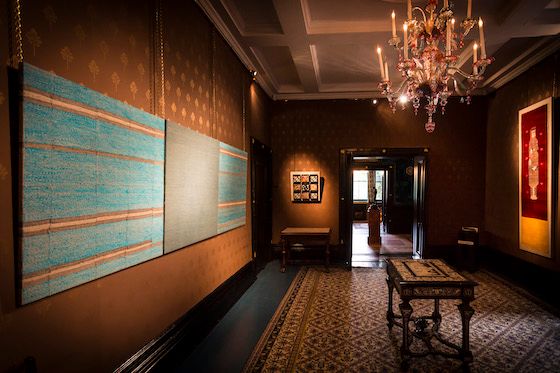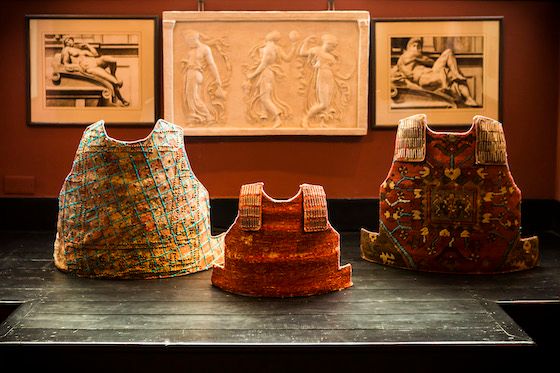In a quiet corner of west London lies a jewel of a museum. Leighton House is the former home of the Victorian artist and collector Frederic, Lord Leighton. He was an orientalist of the old school, picking up treasures from the East on his travels to decorate his house. The remarkable Arab Hall, still intact, is a glorious mishmash of Damascene tiles, Safavid-era painted figures and Pakistani calligraphy—among much more. Elsewhere Leighton’s own paintings—though not his most famous, Flaming June—are displayed.
The house still retains the feel of a working studio—a space for artists to explore and test their reactions. Last Friday I had the privilege of getting a private tour of the ongoing exhibition by Iranian artist Bita Ghezelayagh entitled Lovers of Apadana. Ghezelayagh's work draws on the textile heritage of her native country, and each object she displays here replies to its surroundings in some way. In the Arab Hall, for example, she has created a jacket made out of old Persian carpets rescued from her friends’ attics.
In the salon reception room, where Leighton once hosted Queen Victoria, a coal-black felt coat hangs on the wall, as though waiting to be picked up by a guest. This heavy-looking item is the kind of waterproof covering that Iranian shepherds used, Ghezelayagh told us, until it became cheaper to buy plastic macs. The traditional crafts she seeks to honour are dying out. Her Iranian felt-maker is no longer in business and his sons don't want to take on this time-consuming work. The markets of Mashhad, once teeming with handmade goods, are now full of Chinese factory-made junk. (Though Kashan, just north of Isfahan, is apparently still keeping up the old ways.) Both pieces are decorated with pen nibs which, from a distance, look like bullets—a subtle reflection on freedom of expression.
Born in Italy in 1966, Ghezelayagh grew up in Iran and studied architecture in Paris. She now lives in London with her husband the writer Christopher de Bellaigue. Her work has an irresistible tactile quality: I loved her watery-blue triptych (below) that uses ironed-out coarse bathing scrubbers similar to that which she was rubbed down with as a child. Ghezelayagh invited us to touch the work, to feel the bristles on our skin. Opposite is the centrepiece of the collection: a stunning red and yellow/red and black pair of lovers.

In Leighton’s own bedroom hangs perhaps the most emotionally powerful piece in the exhibition. Two pieces of cloth with flower designs that echo the William Morris wallpaper are joined by a river of deep red stitching. In this work, called “The Wound,” (below) the threads seem to be holding everything together, yet show a fragile vulnerability. One couldn’t help but think of Leighton’s own divided self—he lived alone and never married.

One of the sweetly menacing pieces, though, was the matching armour for an adult and child—drawing on the martial stories in Ferdowsi’s Book of Kings—again covered with old carpet and pen nibs.

This small exhibition will take at most an hour of your time. On a cold winter evening, it’s the perfect place to escape into another world.
Until 5th December












